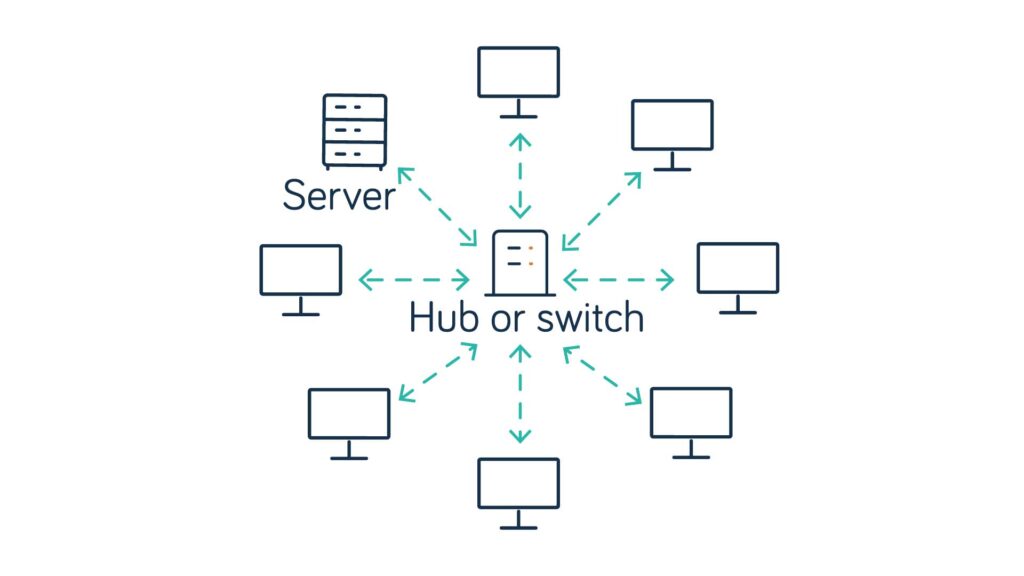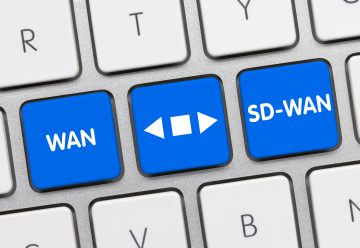What is a LAN (local area network)?
- Neos Networks
- Product interest , WAN ,

Learn all about local area networks (LANs), how they work, types of LAN connectivity, and the benefits of using a LAN.
- What’s a local area network (LAN)?
- What’s the difference between a LAN, WLAN, MAN and WAN?
- What are the benefits of using a LAN?
- How do LANs work?
- Types of LAN connectivity
- LAN topologies
- Virtual LANs (VLANs)
- LANs, WANs and your business
- LAN FAQs
What’s a local area network (LAN)?
A local area network (LAN) is a network of computers or other devices interconnected in one location to enable communication and resource sharing.
A LAN may connect one or two people in an office or home or thousands of users across a corporate campus. Initially developed in the 1960s for use in universities and research facilities, LANs were designed to allow users to communicate and share resources with others in the same building or local area.
Thanks to the emergence of Ethernet technology in the 1980s, LANs became the leading technology to locally link devices in businesses and homes worldwide. Today, LANs typically use wired (Ethernet) or wireless (Wi-Fi) connections, also known as WLAN.
What’s the difference between a LAN, WLAN, MAN and WAN?
LAN, WLAN, MAN and WAN all refer to computer networks, but they differ in geographical size, technologies and purpose.
LAN
A LAN connects devices within a small area, like a workplace or office block. Your home or office network is an example of a LAN. Typically, organisations own the copper or fibre optic cabling, routers and switches that make up a LAN.
WLAN
WLAN stands for wireless local area network. WLANs use radio frequency signals to enable devices to connect and communicate on a local area network without using cables. If you’re reading this on your home or office Wi-Fi, you’re on a WLAN.
MAN
MAN stands for metropolitan area network, which organisations use to connect multiple locations across a city or municipality. MANs generally use fibre optic cables to interconnect sites. While most organisations partner with a telecom company to provide their MAN, some use Dark Fibre and own and manage the networking equipment.
WAN
WAN stands for wide area network, which links an organisation’s sites dispersed across a country or worldwide. Modern, software-defined WANs (SD-WANs) can also connect these dispersed LANs directly to cloud services to create one seamless network. Organisations often rely on telecom providers to create and manage WANs.
What are the benefits of using a LAN?
As the name suggests, a LAN allows you to connect computers and other devices in a local area to send and receive information between them. For example, you connect a printer to your home LAN so you can send it files to print.
LANs allow you to:
- Provide access to local network services, such as printing or application data, without the data going off site
- Access business-critical data stored in one central location
- Share a single wired or wireless internet connection between several devices
- Control and restrict access to your network using security tools like 802.1X authentication
In short, LANs provide a network for collaboration and communication between locally connected devices, whether at home or work.
How do LANs work?
A typical LAN creates a network using ethernet cables, switches, routers and wireless access points (Wi-Fi). Each device on a LAN is assigned a unique internet protocol (IP) address. This maps to a physical address called a MAC (Media Access Control) address on each device, which ethernet switches use to direct data sent across the network.
Below is a simplified diagram of a typical LAN, connecting users to the organisation’s server via a hub or switch.

Local area network (LAN)
However, LANs differ in their connectivity and network structure.
Types of LAN connectivity
Traditionally, a local area network connected devices using ethernet cables. Devices communicate with each other by sending data packets addressed to specific IP addresses across a wired network. Today’s LANs may combine ethernet and wireless connections.
Ethernet
Standardised in the 1980s, ethernet is the most widely used protocol for wired LANs today.
LANs use coaxial, twisted pair copper, or fibre optic cables to form a wired network. Each device must be physically connected to an ethernet switch or router, typically using a twisted pair ethernet cable with RJ45 connectors. Occasionally, devices will connect using fibre optic cables, although these are generally used for servers or to interconnect switches and routers.
WLAN
Apart from ethernet, many LANs include wireless connections (WLAN), such as Wi-Fi. For example, you can connect your computer to your home router using an ethernet cable or Wi-Fi.
LAN topologies
Another way of classifying LANs is by topology – the physical arrangement of devices on the network.

Example LAN network topologies
One of the most common LAN topologies, star networks are relatively easy to install and scale up. Each device connects directly to the central hub or switch. However, if the hub fails, the whole network goes down.
A bus network has fewer cables and is even simpler to install, so they’re typically more cost-effective than a star network. But the bus topology can suffer from signal loss over long distances, so it only works efficiently in small networks.
Unlike bus networks, the ring topology has the advantage of allocating all devices equal access to network resources, making it potentially efficient for small to medium networks. Yet ring networks can be difficult to configure and scale up and are rarely used today.
An increasingly common alternative for more dispersed networks is the mesh topology. In a mesh network, every device on the LAN can communicate with every other without going through a central hub. Several devices can transmit data simultaneously, so they’re suitable for more extensive networks with heavy traffic.
Virtual LANs (VLANs)
In larger organisations with hundreds or thousands of users, you can split up LANs to manage them more efficiently. Instead of using separate LAN infrastructure, you can use software to divide and group users into virtual local area networks (VLANs).
For instance, you can set up VLANs for different departments in your business, making the network easier to manage.
LANs, WANs and your business
If your business has multiple sites dispersed across the country or internationally, setting up the right LANs for your local needs is only half the battle. You’ll want to integrate each site into one secure wide area network (WAN) to maximise company-wide efficiency.
At Neos Networks, we offer a range of managed WAN services, including IP-VPN and SD-WAN, so get in touch. We’ll be happy to design a cost-effective, scalable WAN for your business.
Local area network FAQs
-
What does a local area network do?
A local area network (LAN) interconnects computers and other devices in one location, such as an office, home or school. LANs allow interconnected devices to communicate and share an internet connection, file storage and other resources.
-
What types of devices can connect to a LAN?
Various devices can connect to a LAN, typically by ethernet cable or Wi-Fi (WLAN), including computers, servers, printers, smartphones, tablets, servers, network-attached storage (NAS) drives, and Internet of Things (IoT) devices like smart speakers, lights and TVs.
-
What role do switches and routers play in a LAN?
Switches interconnect devices on the same LAN. They use MAC addresses to direct the network traffic to the correct device on the LAN. By contrast, routers connect LANs to the internet or interconnect various LANs to create a wide area network (WAN).
-
How do you maintain LAN security?
You can ensure your LAN remains secure by regularly updating network security protocols and using security measures, such as encryption, strong passwords, firewalls, and user access controls.
You might also like

Discover our network reach
We can connect you anywhere in the UK
Great news!
"[poscode]" can be reached with our
expanded network
Speak to a representatitive to discuss your options
Contact usLearn about our prices using our online tool, LIVEQUOTE
View LIVEQUOTESorry
"[poscode]" can not be reached with our
expanded network
Speak to a representatitive to discuss your options
Contact usLearn about our prices using our online tool, LIVEQUOTE
View LIVEQUOTE




